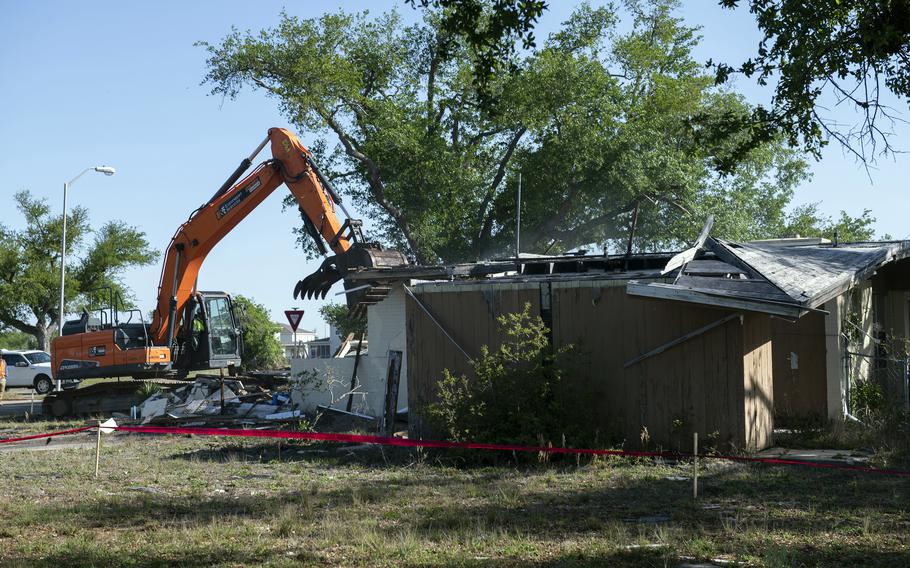
Defense Secretary Lloyd Austin speaks during a Senate Armed Services Committee hearing Tuesday, Sept. 28, 2021, on Capitol Hill in Washington. (Patrick Semansky/AP)
Troops, equipment and installations across the Defense Department must become more resilient to extreme weather conditions that will grow harsher in the coming years amid a changing climate likely to stoke global security and stability problems, a top Pentagon official said Friday.
The Defense Department has been mandated to include climate change adaptation into its planning for small units to top-line strategic efforts to ensure the United States retains its military prowess even under the most difficult conditions, said Richard Kidd, the deputy assistant secretary of defense for environment and energy resilience. He spoke Friday with the Washington-based Defense Writers Group, one day after the Pentagon released its new 32-page strategy to adapt to changing climate.
“We're going to adapt our training, we're going to adapt our plans, policies and procedures. We're going to pivot the entire department towards living … and operating in a reality altered by climate change,” Kidd said, noting the world was growing not only hotter but more volatile as harsher climate leads to problems including food and water scarcity in some parts of the world. “What climate change does is it makes that insecurity, instability more pronounced… I think that insecurity and instability, while they have been in the world for a long time to this point, it’s going to become more pronounced in the years ahead.”
The Pentagon cannot ignore the problem, Kidd said. Officials have fingered climate change as a major problem facing the military in recent years and they have blamed it, in part, for a huge uptick in homeland military operations, especially for the National Guard. In recent years, more troops have spent more time fighting larger and longer-burning wildfires in the western United States and others have been called to respond to increasingly potent hurricanes and flooding in the east. Some of those storms accounted for billions of dollars of damage suffered at coastal military installations in recent years, including major devastation in a pair of 2018 hurricanes at key posts such as Tyndall Air Force Base, Fla., and the Marines’ Camp Lejeune, N.C.
Defense Secretary Lloyd Austin labeled climate change an “existential threat” to the nation’s national security in a statement accompanying the release Thursday of DOD’s Climate Adaptation Plan.

An excavator demolishes a house at Tyndall Air Force Base, Fla., April 1, 2021, that was severely damaged by Hurricane Michael in October 2018. (Tiffany Price/U.S. Air Force)
“The Department of Defense must act swiftly and boldly to take on this challenge and prepare for damage that cannot be avoided,” Austin said in the statement. “Every day, our forces contend with the grave and growing consequences of climate change, from hurricanes and wildfires that inflict costly harm on U.S. installations and constrain our ability to train and operate, to dangerous heat, drought, and floods that can trigger crises and instability around the world.”
The Pentagon plan was one of 23 climate change-focused plans released by federal agencies on Thursday. About one week after President Joe Biden took office, he directed the government’s largest agencies to design new plans to adapt their operations to changing climate and find ways to mitigate the impacts the U.S. federal government has on the changing climate.
While Thursday’s plan focuses on how the department can continue functioning despite the near-term, unavoidable consequences of climate change, the Pentagon’s crucial plans to reduce its own longer-term impact on climate change are forthcoming, Kidd said. The Defense Department expects to release a report later this year detailing its plans to reduce its greenhouse gas emissions, he said.
Greenhouse gases include a number of gases that trap heat in the atmosphere and contribute to climate change, according to the U.S. Environmental Protection Agency. Carbon dioxide, which is emitted from burning fossil fuels among other human activities, accounts for about 80% of human-caused greenhouse gas emissions, according to the EPA.
The Defense Department is the single largest institutional consumer of fossil fuels in the world and emits more greenhouse gas than two-thirds of all the nations on Earth, according to the Pentagon. Kidd said the Pentagon has worked for 10 years to reduce its reliance on carbon-emitting fuels, but it has a lot of improvement still to achieve.
“I think the science is very clear right — we have to reduce our greenhouse gas emissions to zero, and we have to do it before 2050 if we want to avoid the most pronounced effects of climate change,” Kidd said. “All agencies in the federal government are expected to contribute to that objective … so, we’re going to be a part of that effort.”
The strategy announced Thursday instructs the Defense Department to build resiliency into its intelligence and decision-making processes, troop-training efforts, equipment including vehicles and weapons, infrastructure, and supply chain.
For service members, it means taking steps to prepare to fight in the most extreme weather conditions — brutally cold and extremely hot and dry, according to the strategy. It prescribes adding training in areas prone to extreme weather and prioritizing medical skills and first aid meant to mitigate the impacts of extreme heat.
It could also mean new climate-focused education for troops, Kidd said, as the Pentagon works to ensure decision-makers at every level are making “climate-informed decisions.”
“For example, an Army transportation convoy leader should understand that not letting the trucks idle makes both good operational sense as well as good climate sense,” he said.
All of the military’s gear — from rifles and pistols to nuclear-power ships — must also be stress tested to operate in harsh environments, according to the strategy. The Pentagon must pursue technological updates to ensure military gear works in sweltering and frigid conditions, according to the plan.
Installations across the world will have to assess the climate-related impacts that they could face. At Marine Corps Recruit Depot Parris Island, S.C., a climate assessment has already led planners to change the locations of some planned infrastructure projects away from areas impacted by sea level rise, according to the report. Those changes include adjusting the elevation of battalion training facilities. But Parris Island will also take other mitigation steps, the report said, including stormwater and roads upgrades, constructing a tidal exclusion barrier, and planting new forest.
The Defense Department has begun looking at 1,400 of its installations and other properties for expected impacts of climate change, including sea level rise, heat and drought and increased flood levels, Kidd said. It will closely study how to mitigate problems brought by climate change at its existing locations, but it has not reached the point where it is considering any major basing changes solely because of climate impacts, he said.
Ultimately, the Pentagon might have to make such changes — moving certain units or operations to new locations, taking new steps to harden installations against climate impacts, or abandoning some of its installations, Kidd said.
“We know that the past is no longer an indicator of the future,” he said. “If you look to the future, we might get to the point some place where we have to ask those hard questions about what mission sets are located at a particular installation.
“Those are the really hard choices that could be out there in the future for some of our installations, but we're not there yet.”